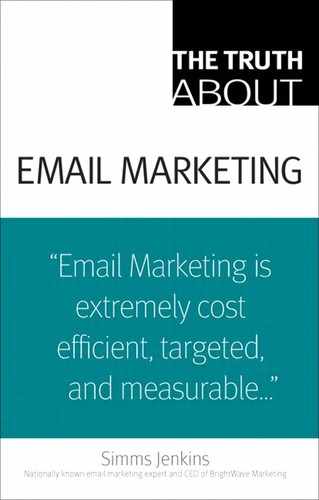Truth 23. Establishing the right email frequency
One of the questions I'm asked the most is, “How often should we send email messages to our list?” Quite simply, there is no simple and catch-all answer to that seemingly easy, yet complicated (and loaded) question. However, there are several rules of thumb to help you make an educated decision regarding the optimal frequency mix for your email marketing deployment calendar.
Not too much and not too little
“Well, no kidding,” you may think. While establishing maximum frequency guidelines is a must (such as never more than two emails per month, per user), you should also consider minimum standards. Whether your list contains 500 or 500,000 people, you should be mailing to it on a monthly basis at the very least. Not meeting this minimum threshold puts you at risk of diluting the permission the subscribers have given.
Think about it: You may have signed up for various newsletters, updates, and alerts from trusted websites and brands, but if you don't hear from them for five months, you may grow disinterested or—worse—forget that you granted them permission to send email communications in the first place. Infrequent messaging could lead to a rise in unsubscribes and spam reports.
When you commit to sending at a certain frequency, make sure you can deliver useful, valuable, and engaging emails on this schedule. It is both about making sure your content is relevant and that you have the internal resources to make it happen.
Never more than once within 48 hours
All bets are off on this one if the email is triggered based on breaking news (such as CNN Breaking News Updates) or other timely content. However, if you are sending a general newsletter or promotional piece, abide by this rule or run the risk of generating unsubscribes and low response rates.
If you didn't achieve the results you wanted on Tuesday, altering the message and redeploying it the next day may get the VP of marketing off your back, but it won't change the way recipients view your email.
I won't offer up any names, but I recently subscribed to an email list for a regional retailer. The retailer sent me two emails in two days. (One was for a women's special, but that is a different story.) I promptly unsubscribed and hope to never see an email from this retailer again. The relationship (off- and online) it built with me was hurt by too frequent email deployments. This is every email marketing manager's worst scenario.
Frequency segmentation
Many companies wisely use list segmentation to determine the different types of content and offers to send unique email messages to customers. You can also use this technique to determine optimal frequency rates. While response from one group of customers may be higher with mailings every week, another group may respond better with a monthly frequency. So consider adjusting frequency for different types of customers based on resulting metrics and insight gathered from response analytics.
Better yet, quit playing the guessing game and ask customers how often they would prefer to hear from you when they opt in. This saves dollars on costly market research and segmentation and ensures that your customers get exactly what they what.
Use your metrics
Frequency should not be as simple as, “We don't mail to our customers more than twice a month.” Just as with any marketing and sales program, email marketing campaigns should be adapted based on the response to each program. Email provides marketers with more information than almost any other marketing medium. This data should be used to evaluate and establish your frequency mix. For instance, if 14 percent of users clicked on the Buy link in your email but only 10 percent of them completed the transaction, wouldn't you consider the ones who clicked but did not buy to be your hot leads? In the offline world, you would probably focus your sales resources on converting this 4 percent.
With email, you have it easier. Tailor a campaign to those folks who have expressed an interest in your product or service, test the creative elements and specific offer or incentive within, and then send it about a week after their original click-through. Keep a close eye on their response. Should you resend an email that soon to the rest of your list? No. The point is to use your metrics as a map to adapt the battle plan and convert the low-hanging fruit.
Rules should guide, not restrict
The key to establishing the right email frequency with your customers, as in every aspect of email marketing, is to plan, test, adapt, analyze, and refine. Each marketer will find that different rules apply for different customers. If you are selling snow tires, you need to be flexible on frequency and make changes according to seasons, sending more email right before winter and relatively few in the spring. If this applies to your company, you'll want to ensure the frequency possibilities and that they may change based on seasons or other factors. Otherwise, you may get mismatched expectation and subscribers getting more or less email than they intended, which might lead to spam complaints and relationship issues.
Although the guidelines I've outlined should help you establish rules for your organization, the key is to always be as flexible as customers’ desires and preferences are quick to shift in this space.
